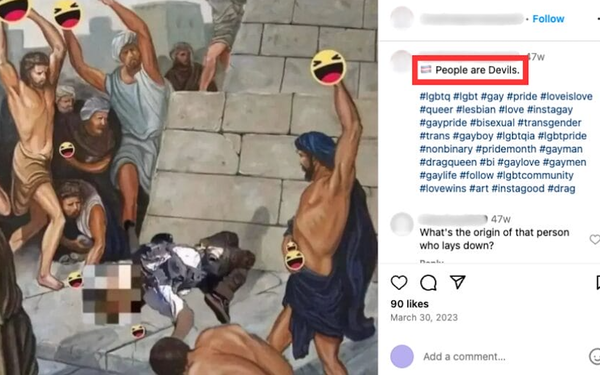
GLAAD found anti-trans content,
like this 2023 Instagram post that calls trans people “devils” and depicts mob violence.
Facebook, Instagram and Threads are full of anti-trans hate, according to an
extensive new report from GLAAD. The posts and images are often dehumanizing and sometimes violent. And even when they violate Meta’s community guidelines, the company frequently deems them not
to be in violation -- or does, but takes no action.
“The company’s ongoing failure to enforce their policies against anti-LGBTQ, and especially anti-trans hate, is simply
unacceptable,” says Sarah Kate Ellis, president and chief executive officer of the advocacy group, in the report.
The research includes dozens of examples of disturbing content, which
GLAAD reported to Meta. GLAAD says most of the posts come from high-follower accounts and often target trans, nonbinary, and gender-nonconforming people with slurs, describing trans people as
“satanic,” “sexual predators,” “terrorists,” “mentally ill,” “perverts,” and “tr*nnies”.
advertisement
advertisement
Some images depict mob violence
aimed at trans people.
The report highlights the conundrum faced by advertisers. Meta is such a powerful platform few can afford to stay away from it, says Yeonhee Lee DeLorenzo, a senior
media director and head of channel at Ogilvy, who was not involved in the report. However, having ads appear on the platform creates brand safety risks, as well as the possibility of upsetting
customers, shareholders, employees, and activists.
“Platforms, not just Meta, are democratized forums. It can get messy, with the potential for chaos,” DeLorenzo tells
Marketing Daily.
The GLAAD report also rated other platforms, which all received failing scores. Instagram got 63%, Facebook 61%, TikTok 57%, YouTube 54% and Twitter 33%.
Advertisers have tried to push Meta to do better. In the summer of 2020, just weeks after the murder of George Floyd ignited global conversations about racism, a group of 1,000 advertisers called
#StopHateForProfit paused advertising on Facebook. The hope was that the loss of revenue would pressure Facebook into better policing the messages of hate, racism and violence. The effort failed
without either denting Meta’s billions in revenues or meaningfully changing its policies.
It's not that advertisers are shrugging concerns off, says DeLorenzo. “They are
approaching it as a business decision. And many are proactively putting brand safety levers into place.”
But guardrails are far from perfect. “Those examples in the GLAAD report
are things that fell through the cracks,” she says.
Perhaps the biggest lesson of 2020 for advertisers, she says, “is how important it is to diversify your media mix. Putting all
your ads on Facebook is not the most strategic decision.” And in testing ads on other platforms, “you just take the good and the bad and look at all the different safety measures that they
may have.”
A GLAAD spokesperson told Marketing Daily the group hopes the report will spur advertisers to pay closer attention. “As Meta continues to refuse to enforce its
policies to protect LGBTQ people from this kind of extreme hate content, it is also failing to protect the valued brands, influencers, and creators who helped build and who advertise on Instagram,
Facebook, and Threads,” the spokesperson says. “The ball is in Meta’s court.”
And while the 2020 boycott failed, Ogilvy’s DeLorenzo points out that a similar
effort could take place again. “That movement did produce a lot of exposure and led many platforms to boost their security,” she says.
No matter what, “social media
isn’t going away,” she says. The best brands can do is closely track the content and context in which their ads appear and understand that the channel is “wildly imperfect.
There’s no social platform where advertisers have absolute control,” she says. “Try to make sure your content is positioned in a way that is aligned with your brand
values.”